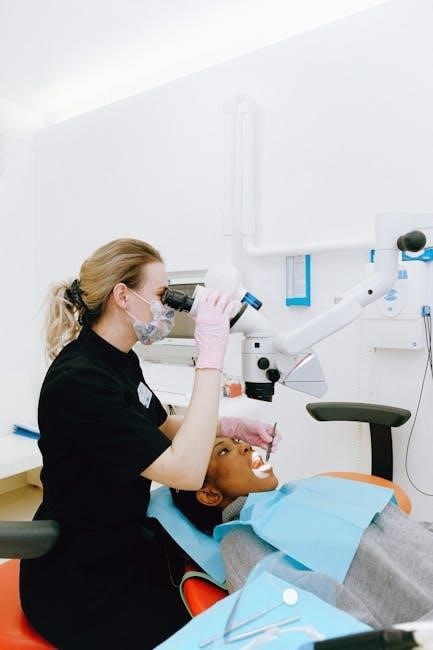
Advanced pharmacology is a critical component of nursing practice, focusing on the safe and effective use of medications. It integrates foundational knowledge of drug mechanisms, therapeutic applications, and patient-specific factors to optimize care. Nurse practitioners must master pharmacological principles to ensure safe prescribing, monitor efficacy, and manage side effects. This section provides an overview of key concepts, emphasizing the importance of pharmacology in clinical decision-making and patient outcomes.
1.1 Importance of Pharmacology in Nursing Practice
Pharmacology is essential in nursing practice as it ensures safe and effective medication management. Nurses must understand drug mechanisms, side effects, and interactions to provide high-quality patient care. This knowledge enables them to monitor for adverse reactions, educate patients, and optimize therapeutic outcomes. Pharmacology also plays a key role in preventing medication errors, a leading cause of patient harm. By mastering pharmacological principles, nurse practitioners can prescribe appropriately, adhere to legal standards, and improve patient safety. This expertise is critical in addressing complex health conditions and ensuring evidence-based practice in diverse clinical settings.
1.2 Key Concepts in Pharmacology
Key concepts in pharmacology include pharmacokinetics (how drugs move through the body) and pharmacodynamics (drug effects on the body). Understanding drug absorption, distribution, metabolism, and excretion is vital for effective dosing. Therapeutic indices and drug interactions are also critical, as they influence safety and efficacy. Nurses must grasp pharmacogenomics, which tailors drug therapy to genetic factors, and be aware of adverse effects. These concepts guide evidence-based prescribing, ensuring medications are used appropriately. Mastery of these principles helps nurse practitioners optimize patient outcomes, minimize risks, and deliver personalized care. This knowledge is foundational for advancing nursing practice and improving therapeutic decision-making.
Foundational Principles of Pharmacology
Foundational principles of pharmacology include pharmacokinetics and pharmacodynamics, which govern drug movement and effects in the body. These principles guide therapeutic dosing, efficacy, and safety, ensuring optimal patient outcomes through evidence-based practice.
2.1 Pharmacokinetics
Pharmacokinetics involves the study of drug absorption, distribution, metabolism, and excretion in the body. Understanding these processes is essential for nurse practitioners to determine appropriate dosing, ensure therapeutic effectiveness, and minimize adverse effects. Factors such as patient age, organ function, and drug interactions significantly influence pharmacokinetics. For instance, renal impairment can slow drug excretion, leading to toxicity; Similarly, hepatic metabolism affects drug clearance, necessitating dose adjustments in patients with liver disease. Nurse practitioners must consider these principles to tailor medication regimens to individual patient needs, optimizing safety and efficacy in clinical practice.
2.2 Pharmacodynamics
Pharmacodynamics examines the effects of drugs on the body, focusing on drug-receptor interactions, dose-response relationships, and therapeutic windows. It explains how medications produce desired effects at the cellular level. Understanding pharmacodynamics helps nurse practitioners predict drug responses, optimize dosing, and minimize toxicity. Factors like receptor affinity and drug concentration influence efficacy, while individual variability (e.g., age, genetics) can alter responses. Grasping pharmacodynamic principles enables precise medication selection, dosing adjustments, and monitoring strategies to enhance patient outcomes. This knowledge is vital for safe and effective prescribing, ensuring therapeutic goals are met while reducing adverse effects in diverse patient populations.
Therapeutic Drug Classes
Therapeutic drug classes target specific conditions, such as cardiovascular, neurological, and infectious diseases. Each class has unique mechanisms, benefits, and risks, requiring tailored use for optimal patient outcomes.
3.1 Cardiovascular Drugs
Cardiovascular drugs are essential for managing conditions like hypertension, heart failure, and coronary artery disease. Common classes include beta-blockers, ACE inhibitors, diuretics, and statins. Beta-blockers reduce heart rate and blood pressure, while ACE inhibitors dilate blood vessels and decrease cardiac workload. Diuretics help manage fluid retention, and statins lower cholesterol to prevent atherosclerosis. Nurse practitioners must understand these drugs’ mechanisms, indications, and side effects to tailor therapies. Monitoring parameters like blood pressure, heart rate, and lipid profiles is crucial. Patient education on adherence and lifestyle modifications complements pharmacotherapy, ensuring optimal cardiovascular health and minimizing complications.
3.2 Neurological Drugs
Neurological drugs are tailored to manage conditions like epilepsy, Parkinson’s disease, multiple sclerosis, and Alzheimer’s. Anticonvulsants stabilize neuronal activity, while dopaminergics enhance dopamine levels in Parkinson’s. Immunomodulators reduce inflammation in multiple sclerosis, and cholinesterase inhibitors improve cognitive function in Alzheimer’s. Nurse practitioners must monitor for side effects, such as liver toxicity with anticonvulsants or psychiatric effects with dopaminergics. Regular neurological assessments and patient education on adherence, potential side effects, and lifestyle modifications are crucial. These drugs require careful titration and individualized regimens to balance efficacy and tolerability, ensuring optimal neurological outcomes and improved quality of life for patients.
3.3 Infectious Disease Drugs
Infectious disease drugs target pathogens like bacteria, viruses, fungi, and parasites. Antibiotics, such as penicillins and cephalosporins, inhibit bacterial growth, while antivirals like oseltamivir combat viral replication. Antifungals, including fluconazole, treat fungal infections, and antiparasitics address conditions like malaria. Nurse practitioners must consider factors like resistance patterns, drug interactions, and patient-specific needs. Proper dosing, duration, and monitoring for side effects, such as nephrotoxicity or hepatotoxicity, are critical. Educating patients on adherence and potential side effects ensures effective treatment and minimizes resistance. These drugs require a tailored approach to balance efficacy and safety, making them a cornerstone in managing infections across diverse patient populations.
Safe Prescribing Practices
Safe prescribing practices ensure accurate medication orders, adherence to current guidelines, and minimization of risks. They involve thorough patient assessments, proper documentation, and regular monitoring for efficacy and safety.
4.1 Principles of Safe Prescribing
Safe prescribing practices are essential for minimizing medication errors and ensuring patient safety. Key principles include conducting thorough patient assessments, using evidence-based guidelines, and avoiding unnecessary medications. Prescribers must verify dosages, contraindications, and drug interactions. Accurate documentation of medical history, allergies, and current medications is critical. Regular monitoring of treatment efficacy and potential side effects ensures timely adjustments. Open communication with patients and other healthcare providers fosters collaboration and reduces risks. Adhering to legal and ethical standards, including proper use of controlled substances, is vital. These practices help prevent adverse events, optimize therapeutic outcomes, and uphold professional accountability in patient care settings.
4.2 Monitoring for Efficacy and Side Effects
Monitoring for efficacy and side effects is crucial to ensure therapeutic outcomes and patient safety. Regular patient assessments, including physical exams and laboratory tests, help evaluate drug effectiveness. Nurses should observe for adverse reactions, such as allergic responses or organ toxicity. Patient-reported symptoms and changes in vital signs are key indicators; Timely documentation of findings guides adjustments in treatment plans. Open communication with patients and healthcare providers fosters trust and collaboration. Proactive monitoring prevents complications, enhances therapy adherence, and improves overall care quality. This process ensures medications are used safely and effectively, aligning with patient goals and promoting optimal health outcomes.
4.3 Patient Education on Medications
Patient education on medications is a critical component of safe and effective care. Nurses should provide clear, concise information about drug names, purposes, dosages, and administration schedules. Emphasizing potential side effects, allergic reactions, and when to seek help is essential. Patients should also be advised on proper storage and disposal of medications. Encouraging adherence to prescribed regimens and addressing concerns fosters trust and compliance. Cultural competence and language accessibility are vital to ensure understanding. Using visual aids or written instructions can reinforce learning. Educating patients empowers them to manage their health safely and effectively, reducing errors and improving therapeutic outcomes.

Legal and Ethical Considerations
Understanding legal standards, licensure requirements, and ethical frameworks is essential for nurse practitioners. Adhering to prescribing laws, avoiding malpractice, and maintaining patient confidentiality are critical responsibilities.
5.1 Legal Aspects of Prescribing
Nurse practitioners must adhere to legal standards governing prescribing practices, ensuring compliance with state and federal laws. Proper licensure and authority to prescribe medications are essential. Understanding legal implications, such as liability for errors or misuse, is critical. Documentation of prescriptions and patient interactions must align with regulatory requirements. Staying informed about changes in prescribing laws and controlled substance regulations is vital. Non-compliance can lead to legal consequences, including loss of licensure. Ethical prescribing practices, including avoiding conflicts of interest, are also legally mandated. Collaboration with healthcare teams and adherence to institutional policies further support legal prescribing standards.
5.2 Ethical Issues in Pharmacology
Ethical issues in pharmacology require nurse practitioners to balance patient autonomy with beneficence and non-maleficence. Informed consent is crucial, ensuring patients understand medication benefits and risks. Confidentiality must be maintained, particularly when managing sensitive conditions. Cultural beliefs and practices may influence adherence, necessitating respectful and individualized care. Avoiding conflicts of interest, such as promoting specific drugs for personal gain, is essential. Ethical dilemmas may arise in resource-limited settings or when prioritizing treatments. NPs must also address disparities in access to medications and advocate for equitable care. Ethical prescribing fosters trust and promotes optimal patient outcomes, aligning with professional standards and patient-centered values.
5.3 Avoiding Malpractice in Prescribing
Avoiding malpractice in prescribing requires nurse practitioners to prioritize accuracy, safety, and adherence to professional standards. Conduct thorough patient assessments, ensuring prescriptions align with evidence-based guidelines. Verify dosages, contraindications, and potential drug interactions to prevent harm. Document all decisions and patient interactions meticulously. Stay updated on pharmacological advancements and legal requirements. Foster open communication with patients about medication risks and benefits. Collaborate with healthcare teams to address complex cases. Regularly monitor patients for adverse effects and treatment efficacy. Maintain confidentiality and avoid conflicts of interest. By integrating these practices, NPs can minimize liability risks and provide high-quality, ethical care, ensuring patient safety and trust in their expertise.
Pharmacogenomics
Pharmacogenomics studies how genetic variations influence drug responses, enabling personalized treatment. It helps predict efficacy and side effects, guiding tailored therapies to improve patient outcomes and safety.
6.1 Concept of Pharmacogenomics
Pharmacogenomics is the study of how genetic variations influence an individual’s response to medications. It examines the relationship between genetic makeup and drug efficacy, toxicity, and metabolism. By identifying specific genetic markers, healthcare providers can predict which patients are likely to benefit from certain drugs and those at risk of adverse effects. This field aims to personalize treatment, enhancing therapeutic outcomes and minimizing harm. Nurse practitioners play a key role in applying pharmacogenomic principles, ensuring tailored drug regimens based on genetic profiles. Understanding this concept is vital for advancing precision medicine and improving patient care in diverse clinical settings. It bridges genetics and pharmacology for better health outcomes.
6.2 Application in Clinical Practice
Pharmacogenomics is increasingly applied in clinical practice to personalize treatment plans based on genetic information. By analyzing genetic variations, healthcare providers can predict drug responses, optimizing efficacy and reducing adverse effects. Nurse practitioners use pharmacogenomic data to guide medication selection, dosing, and monitoring, particularly for drugs with narrow therapeutic indices. For example, genetic testing for enzymes like CYP2D6 and CYP2C19 informs the use of antidepressants and anticoagulants. This approach enhances patient safety, improves outcomes, and minimizes trial-and-error prescribing. As technology advances, pharmacogenomics is becoming integral to precision medicine, enabling tailored therapies and transforming patient care in diverse clinical settings. Ongoing education is crucial for nurse practitioners to integrate this knowledge effectively.

Pharmacology in Primary Care
Primary care pharmacology focuses on managing chronic diseases, acute conditions, and preventive care. Nurse practitioners use evidence-based prescribing to optimize patient outcomes in diverse clinical settings.
7.1 Managing Chronic Diseases
In primary care, nurse practitioners play a vital role in managing chronic diseases such as diabetes, hypertension, and heart failure. Pharmacological interventions are tailored to individual patient needs, focusing on reducing symptoms, slowing disease progression, and improving quality of life. Medications are selected based on evidence-based guidelines and patient-specific factors, including comorbidities and potential drug interactions. Regular monitoring of therapeutic effects and side effects is essential to ensure safe and effective treatment outcomes. Additionally, patient education on medication adherence and lifestyle modifications is crucial for successful chronic disease management.
7.2 Mental Health Disorders
Nurse practitioners play a crucial role in managing mental health disorders such as depression, anxiety, and bipolar disorder. Pharmacological treatments, including antidepressants (e.g., SSRIs, SNRIs) and mood stabilizers, are often prescribed to alleviate symptoms and improve patient outcomes. It is essential to consider factors like side effect profiles, patient history, and potential drug interactions when selecting medications. Non-pharmacological approaches, such as psychotherapy, are also integrated into comprehensive care plans. Regular monitoring of therapeutic responses and adherence to treatment is vital to ensure effectiveness and minimize adverse effects. Patient education on medication use and lifestyle modifications further supports recovery and long-term mental health management.
Geriatric Pharmacology
Geriatric pharmacology focuses on managing medications in elderly patients, addressing polypharmacy and age-related physiological changes that alter drug responses. Nurses must tailor dosages to prevent toxicity and monitor for adverse effects.
8.1 Polypharmacy in the Elderly
Polypharmacy, defined as the use of multiple medications, is prevalent among the elderly and increases the risk of adverse drug interactions and complications. Nurse practitioners must assess the necessity of each medication, considering potential drug-drug interactions and age-related changes in metabolism. Simplifying regimens and deprescribing unnecessary medications can reduce risks and improve patient outcomes. Regular monitoring and patient education are essential to ensure safe and effective medication management in this vulnerable population.
8.2 Age-Related Physiological Changes
Aging is associated with significant physiological changes that impact drug pharmacokinetics and pharmacodynamics. Decreased renal function, reduced hepatic metabolism, and altered body composition (e.g., increased fat, decreased water) affect drug distribution and clearance. Elderly patients often experience heightened sensitivity to medications due to changes in receptor affinity and homeostatic mechanisms. Additionally, age-related declines in gastrointestinal function and immune response can influence drug absorption and efficacy. These factors necessitate careful consideration in prescribing practices to avoid toxicity and ensure therapeutic effectiveness. Regular monitoring and dose adjustments are critical to optimize outcomes and minimize risks in geriatric populations.

Pediatric Pharmacology
Pediatric pharmacology focuses on safe and effective medication use in children, considering their unique anatomical, physiological, and developmental differences. Dosing is tailored to age, weight, and organ maturity to minimize risks and optimize outcomes.
9.1 Dosing Considerations
Pediatric dosing requires careful calculation based on age, weight, and organ maturity. Unlike adults, children’s doses are often weight-based to ensure safety and efficacy. Renal and hepatic immaturity affect drug metabolism, necessitating lower starting doses. Nurses must consider developmental stages, as neonates, infants, and adolescents have varying physiological capabilities. Precise calculations are critical to avoid underdosing or toxicity. Special populations, such as premature infants or those with chronic conditions, require individualized plans. Adherence to pediatric-specific guidelines and regular monitoring are essential to optimize outcomes and minimize risks in this vulnerable population.
9.2 Safety in Children
Safety in pediatric pharmacology is paramount due to children’s unique physiological differences. Their developing organs affect drug metabolism, increasing the risk of adverse effects. Dosage errors and off-label medication use are common concerns, requiring meticulous monitoring for efficacy and toxicity. Clear communication with parents/guardians ensures safe administration and adherence. Utilizing pediatric-specific guidelines and dosing charts minimizes risks. Nurse practitioners must stay updated on pediatric pharmacology research to optimize outcomes and prevent complications in this vulnerable population.
Cultural Competence in Pharmacology
Cultural competence in pharmacology involves understanding and respecting diverse patient beliefs, practices, and values to ensure safe and effective medication use across varied populations.
10.1 Impact on Medication Adherence
Cultural competence significantly influences medication adherence, as patients’ beliefs, values, and practices shape their acceptance of treatment. Language barriers and health literacy disparities can hinder adherence. Nurses must address these factors by providing culturally sensitive education and communication. Understanding patients’ cultural backgrounds helps tailor interventions, improving trust and treatment outcomes. Incorporating cultural beliefs into care plans can enhance adherence. Effective strategies include using interpreters, patient-centered counseling, and respecting traditional practices. Addressing cultural factors ensures equitable care and better health outcomes.
10.2 Cultural Beliefs and Practices
Cultural beliefs and practices profoundly influence patients’ perceptions of health and illness, shaping their attitudes toward medications. Many cultures prefer traditional remedies over conventional drugs, while others may harbor fears about side effects or distrust in Western medicine. Language barriers and differing health literacy levels further complicate adherence. Nurses must recognize these dynamics to provide culturally sensitive care. Understanding a patient’s cultural background allows for tailored interventions, such as incorporating traditional remedies when appropriate or addressing spiritual beliefs that impact treatment. Cultural assessments and patient education are essential tools for bridging these gaps and fostering trust, ultimately enhancing therapeutic outcomes and patient satisfaction.

Technology in Pharmacology
Technology in pharmacology enhances medication management through e-prescribing systems, reducing errors and improving efficiency. Mobile apps also empower patients to track dosages, fostering better adherence and engagement in care.
11.1 E-Prescribing Systems
E-prescribing systems are digital tools that enable healthcare providers to electronically transmit prescriptions to pharmacies. These systems enhance accuracy by reducing handwriting errors and improve efficiency in clinical workflows. By integrating with electronic health records (EHRs), they provide real-time patient information, such as medication histories and potential drug interactions. E-prescribing also supports adherence to clinical guidelines and reduces fraud by eliminating altered or forged prescriptions. Additionally, these systems often include decision-support features, such as drug-drug interaction alerts and dosage recommendations, which aid nurse practitioners in making informed prescribing decisions. Secure and compliant with regulations, e-prescribing systems are a cornerstone of modern pharmacology, enhancing both patient safety and care quality.
11.2 Mobile Apps for Medication Management
Mobile apps for medication management are innovative tools designed to improve adherence and streamline care. These apps allow patients to track dosing schedules, set reminders, and maintain a record of medications. Features such as medication diaries, drug interaction alerts, and side effect tracking enhance patient safety. Apps also provide educational resources, helping patients understand their treatments better. For nurse practitioners, these tools offer insights into patient adherence and potential issues, enabling proactive interventions. By fostering better communication between patients and providers, mobile apps play a vital role in optimizing therapeutic outcomes and supporting personalized care in advanced pharmacology practices.
Medication Errors and Adverse Effects
Medication errors and adverse effects are critical issues in healthcare. Monitoring and prevention strategies are essential to ensure patient safety and optimal therapeutic outcomes. Nurse practitioners play a key role in identifying and managing these issues, ensuring safe and effective patient care.
12.1 Identification and Prevention
Identifying and preventing medication errors requires a proactive approach, including thorough patient assessments and medication reconciliation. Utilizing search strategies with Boolean operators and keywords helps in identifying relevant information. Monitoring for adverse effects through patient reports and lab results is crucial. Implementing barcode scanning and electronic health records reduces errors. Nurse practitioners should educate patients on proper medication use and potential side effects. Regular reviews of medication lists and dosages ensure safety. Staying updated on pharmacological advancements through continuing education is essential. By combining these strategies, healthcare providers can significantly minimize medication errors and improve patient outcomes.
12.2 Management Strategies
Effective management of medication errors involves prompt identification, documentation, and corrective actions. Root cause analysis helps determine error origins, while patient monitoring ensures early detection of adverse effects. Clear communication with the healthcare team and patient is vital for transparency and trust. Implementing e-prescribing systems and barcode scanning reduces dispensing errors. Education on proper dosing, administration, and side effects empowers patients and caregivers. Regular audits and feedback loops improve adherence to safety protocols. Nurse practitioners play a key role in updating treatment plans and reporting incidents to prevent recurrence. Proactive strategies enhance patient safety and minimize harm, fostering a culture of accountability and continuous improvement.
Continuing Education for Nurse Practitioners
Continuing education is essential for nurse practitioners to stay current with advances in pharmacology and clinical practices. It ensures they maintain expertise in prescribing medications safely and effectively. Through workshops, online courses, and professional conferences, NPs can enhance their knowledge of new drug therapies, dosage adjustments, and potential interactions. Case studies and peer discussions provide practical insights, fostering improved patient outcomes. Continuing education also addresses emerging trends, such as pharmacogenomics and technology-driven tools, enabling NPs to integrate evidence-based practices into their care. Regular updates in pharmacology empower NPs to make informed decisions, reducing medication errors and improving patient safety.
Future Trends in Pharmacology
Future trends in pharmacology emphasize personalized medicine, where treatments are tailored to individual genetic profiles and environmental factors. Pharmacogenomics will play a pivotal role in predicting drug responses, enabling precise dosing and minimizing side effects. Advances in technology, such as AI-driven drug development and predictive analytics, will revolutionize how medications are discovered and prescribed. Nurse practitioners will leverage e-prescribing systems and mobile health apps to enhance medication management and patient engagement. Additionally, there will be a growing focus on patient-centered care, integrating education and shared decision-making to improve adherence and outcomes. These trends highlight the evolving landscape of pharmacology, prioritizing safety, efficacy, and innovation in patient care.